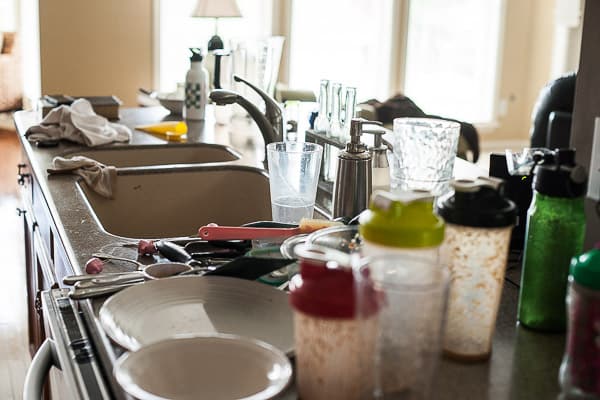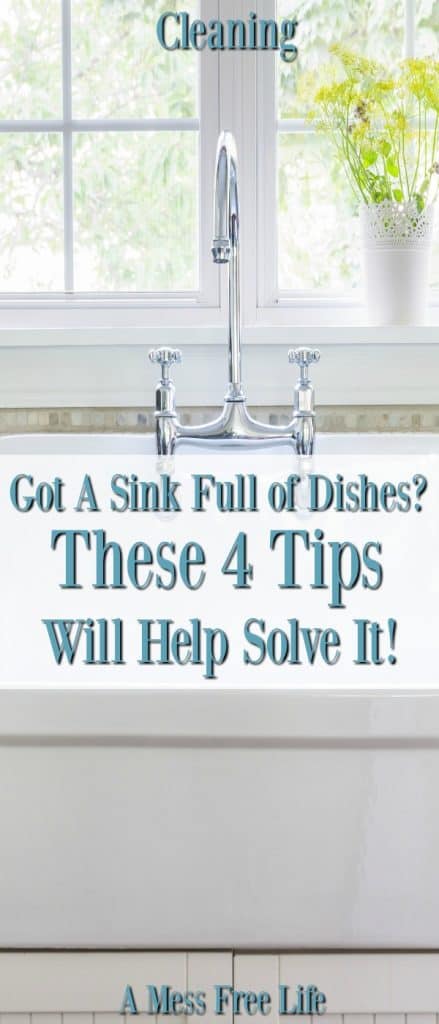A Mess Free Life may collect a share of sales or other compensation from the links on this page.
We all know that feeling of dread that washes over you every time you see a sink full of dishes. Managing the never-ending pile of dishes is one of the worst household chores there is. Well, maybe second only to the dreaded laundry. They seem to take on a life of their own, multiplying right before your eyes and there’s nothing you can do to stop it.
I hate a sink full of dishes. I remember when my daughter was younger. It never failed. I would come home from work and find dirty dishes in the sink. I can’t tell you how many times I would ask her why she left them there instead of in the dishwasher which was empty? Of course, she didn’t have a great answer – she was a teenager. But it frustrated me nevertheless.
Does this sound like your household?
If it does we have some great tips to help you and your family finally get a grip on the dish issue and manage the dishes like a champ!
Table of Contents
THE SECRET TO MANAGE THE DISHES
Would it surprise you to know that dirty dishes are related to staying in debt? Yes, that pile in your kitchen sink may be more than a chore; it may be a contributing factor to your debt. Why?
Why?
Because for most people, when faced with a sink full of dirty dishes they would rather go out to eat than deal with the mess before cooking dinner. Those dirty dishes could be throwing your monthly budget off-track and contributing to a higher monthly credit card bill. Especially if this happens to you once or twice a week.
So how do you manage the dishes so they don’t pile up, making your kitchen look like a mess, and don’t blow your budget on eating out?
Well first, you have to stop ignoring the dishes and face them head-on. In reality, it’s not a pleasant chore but it usually doesn’t take very long; especially if you keep up with it. Whether you wash by hand, use a dishwasher, or a little of both, doing them regularly will keep the dishes from taking over your sink.
EMPTY THE DISHWASHER
One of the easiest and fastest things you can do to manage the dishes is to empty the dishwasher as soon as the load is done. Putting the clean dishes away only takes a few minutes and makes room for the dirty ones to go right in so they don’t stack up.
If a stack has already started in the sink while the dishwasher was going, get those dishes right into the dishwasher. An empty sink gives your kitchen a clean look. And if the dirty ones fill the newly emptied dishwasher, go ahead and start another load. This whole process shouldn’t take more than 10-15 minutes.
LET THEM SOAK
Putting dishes with caked-on food in the dishwasher is okay if you have a nice new dishwasher that cleans well. But if your dishwasher is an older model and maybe doesn’t clean as well as you’d like, putting dishes with caked-on food in will make your job harder.
The food will not completely dissolve so it will redeposit as sand-like specs on all of your other dishes during the washing process. Then the heated drying will set those particles on your other dishes giving everything a sandy finish. If this happens, you now have to scrub and rewash the entire load.
Instead of all of this extra hassle, get your dishes clean the first time by letting the ones with caked-on food soak in hot water and dish liquid for a bit. This will break down the grease and food particles, allowing you to easily wipe any residue out before putting in the dishwasher or finishing by hand.
WASH IN ORDER
If washing by hand, it’s important to wash your dishes in order so that the water doesn’t become greasy and dirty before you’ve finished. Start by filling any dirty pots and pans with hot soapy water and letting them soak while you wash everything else.
Then move on to the cleanest dishes first, usually glasses then silverware. Next, scrape any extra food off your plates and wash those next. And finally, the pots and pans. If you’re using cast-iron cookware, wash that last after you’ve rinsed all the soap from your sink.
Finally, give your sink a good rinse. If you have a garbage disposal, keep it clean by freezing white vinegar and lemon wedges into ice cubes then dropping one or two down the disposal and turn it on.
DRY WELL
All of those dishes you washed by hand now need to be dried; making the dishwashing process even longer. You can make drying a little easier by placing an oven rack or cookie cooling rack over your sink and laying your glasses, bowls, and utensils on it. This way, they can start to drip dry right into the sink.
Keep lots of absorbent dish towels on hand to make drying faster and easier. Bar Mop towels are a great option as they’re made for soaking up spills. You can even lay a couple down on your kitchen counter and lay your clean dishes on them. They’ll start drip drying right to the towel.
Another great option if you have the space is to install a dish draining area over your sink. If there is a cabinet over your sink that you can close (and hide those dishes while they dry) install a couple of shelves with slats, like closet organizers. This gives you extra space for placing your clean dishes and they can drip-dry out of site.
Now that you have a handle on washing and drying, here are a few extra tips for those tough clean-ups:
• Clean a burnt pan with a combination of white vinegar and baking soda. Let it rest for a bit to give it time to work its magic.
• Hot water makes starches and dairy gummy so wash or soak in cold water.
• Clean your blender by filling part way with warm soapy water and turning it on.
• For delicate china and crystal that you need to hand wash, line your sink with terry cloth towels or thick Bar Mop towels to protect them in case they fall or drop.
• Using too much soap can make it harder to wash it all off. Try this to make sure you use just the right amount – squirt about a tablespoon of dish soap in a bowl and add a cup of water. When you need more soap, just dip your sponge in the bowl.
• Contrary to what you may have heard, microwaves and dishwasher don’t remove all the germs from your sponge. To make sure you’re not re-depositing germs and grime on your dishes, replace your sponge once a week and use a ventilated sponge rack to let it air dry.
CONCLUSION
Don’t let the dishes get out of control; if they do they will be harder to manage. Keeping up with them on a daily basis allows you to manage them quickly and easily before they cause even more chaos in your kitchen.



